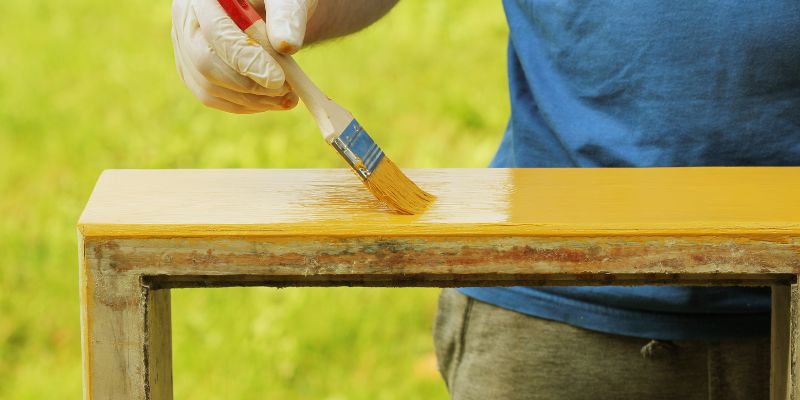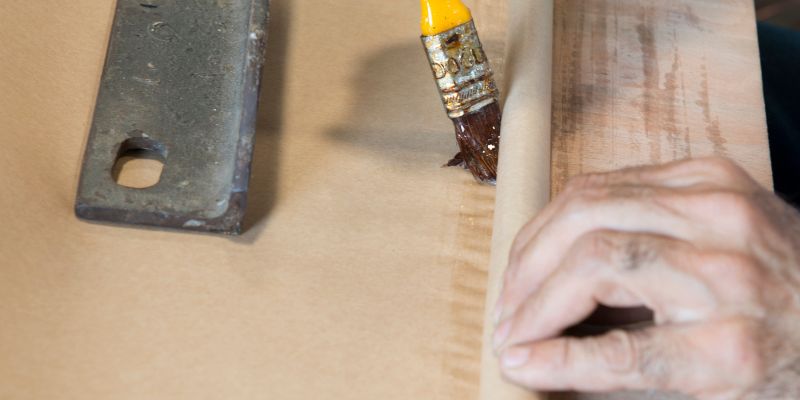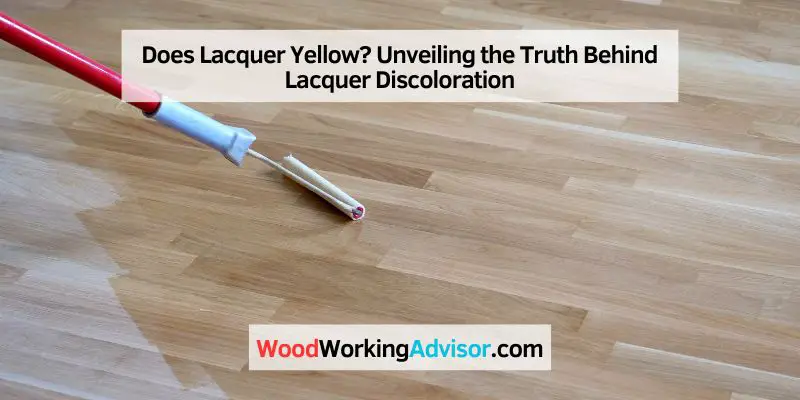Lacquer can yellow over time due to exposure to light and air. This can occur on various surfaces such as furniture, artwork, and even nails.
The yellowing process is a natural reaction as the lacquer ages and undergoes oxidation. While it may be concerning for those who want to maintain the original appearance of their lacquered items, there are steps that can be taken to prevent or minimize the yellowing effect.
Understanding the causes and methods to mitigate lacquer yellowing can help preserve the beauty and longevity of lacquered objects. We will explore why lacquer yellowing happens and some effective strategies to prevent or address this issue.
The Science Behind Lacquer Discoloration
When it comes to the beauty and durability of lacquer finishes, one common concern among consumers is the potential for discoloration over time. The once vibrant and glossy lacquer can gradually turn yellow, diminishing its aesthetic appeal and leaving many wondering why this happens. In this article, we will delve into the science behind lacquer discoloration, exploring the chemical composition of lacquer and the factors that contribute to its yellowing.
Chemical Composition Of Lacquer
Lacquer is a widely used finish in various industries due to its exceptional durability and glossy appearance. Understanding its chemical composition is crucial in uncovering the reasons behind its yellowing. Typically, lacquer consists of several components, including:
| Component | Description |
|---|---|
| Resins | These polymers provide adhesion and resistance to chemicals and abrasions. |
| Solvents | These volatile liquids aid in the application and drying process of lacquer. |
| Pigments | Additives that give lacquer its desired color and opacity. |
| UV stabilizers | These compounds protect the finish from the damaging effects of sunlight. |
The chemical composition of lacquer can vary depending on the specific application and manufacturer. However, it is the interaction between these components and external factors that ultimately leads to the yellowing of the lacquer.

Factors Contributing To Lacquer Discoloration
While the chemical composition of lacquer sets the foundation for its performance, external factors play a significant role in its discoloration. Here are some key factors that contribute to the yellowing of lacquer:
- Exposure to UV light: Ultraviolet (UV) radiation from sunlight and fluorescent lighting can initiate a photochemical reaction, causing the lacquer to yellow over time.
- Aging and oxidation: As the lacquer ages, it undergoes an oxidation process, leading to the breakdown of its chemical structure and the formation of yellowing compounds.
- Temperature and humidity: Extreme temperatures and high humidity levels can accelerate the yellowing process by promoting chemical reactions within the lacquer.
- Chemical exposure: Certain chemicals found in cleaning agents, tobacco smoke, and household products can chemically react with the lacquer, resulting in discoloration.
By understanding the scientific factors that contribute to lacquer discoloration, we can take proactive measures to mitigate its effects. Proper maintenance, regular cleaning, and minimizing exposure to harmful elements can help preserve the beauty and longevity of lacquer finishes.
Common Misconceptions About Lacquer Yellowing
When it comes to lacquer finishes, one common concern is yellowing over time. Many people believe that this yellowing is solely caused by exposure to sunlight. However, this is just one of the many misconceptions about lacquer yellowing. Understanding the true factors involved can help you make informed decisions when it comes to choosing lacquer finishes that will stand the test of time.
Myth: Sunlight Is The Sole Cause
Many assume that sunlight alone is responsible for the yellowing of lacquer finishes. While it is true that UV rays can contribute to this process, it is not the sole cause. The reality is that multiple factors come into play, and it is important to consider all of them in order to prevent or minimize yellowing.
Reality: Multiple Factors At Play
When it comes to lacquer yellowing, it is essential to understand that sunlight is just one of the contributing factors. Humidity, temperature, chemicals, and age are equally important. Let’s look at each of these factors in more detail:
- Humidity: High levels of humidity can accelerate the yellowing process. Moisture in the air can react with the lacquer, causing it to yellow more quickly.
- Temperature: Extreme temperatures, both hot and cold, can have a negative impact on the lacquer finish. Rapid fluctuations in temperature can cause the finish to deteriorate and become more prone to yellowing.
- Chemicals: Exposure to certain chemicals, such as household cleaning products or strong solvents, can lead to yellowing. It is important to make sure that any cleaning agents used on lacquer finishes are gentle and specifically designed for this purpose.
- Age: Over time, even without exposure to sunlight or other external factors, lacquer finishes may naturally yellow due to the aging process. This is especially true for older lacquer finishes that may not have been formulated with the same level of UV protection as modern options.
By understanding these multiple factors at play, you can take steps to minimize the yellowing of lacquer finishes. This includes choosing lacquer with UV protection, controlling humidity levels, avoiding extreme temperatures, using gentle cleaning agents, and considering the natural aging process when evaluating finishes.
Preventive Measures And Maintenance
Preventive measures and maintenance are essential to keep lacquer finishes pristine and prevent yellowing. By taking proper care, you can prolong the lifespan of lacquer and maintain its original appearance.
Protective Coatings And Finishes
To prevent lacquer from yellowing, consider using protective coatings and finishes. Polyurethane and epoxy coatings provide a durable barrier against environmental factors that can cause yellowing. When applying these coatings, ensure the surface is clean and free of dust or debris to achieve a smooth, even finish.
Proper Storage And Handling
Proper storage and handling are crucial in preventing lacquer from yellowing prematurely. Store lacquer-coated items away from direct sunlight and extreme temperatures, as prolonged exposure can accelerate yellowing. Avoid placing items in damp, humid environments, as moisture can also impact the integrity of the lacquer finish.
Restoration And Repair Techniques
Restoring and repairing yellowed lacquer can be a challenging task, but with the right techniques, it is possible to bring back its original beauty. In this section, we will explore the process of identifying yellowed lacquer and various restoration methods that can help you revive your cherished pieces.
Identifying Yellowed Lacquer
Before diving into restoration methods, it’s important to identify whether the lacquer has indeed yellowed. Yellowing can occur due to various factors such as age, exposure to sunlight, or improper storage conditions. Here are a few signs that can help you determine if your lacquer has yellowed:
- Change in color: Yellowed lacquer typically exhibits a noticeable color shift, ranging from a subtle cream tint to a deep amber hue.
- Surface texture: In many cases, yellowed lacquer may also have a slightly sticky or tacky surface texture.
- Damage to the lacquer: Scratches, cracks, or discoloration in specific areas of the lacquer can indicate yellowing.
If you observe one or more of these signs, it’s time to move on to the restoration phase.
Restoration Methods
Restoring yellowed lacquer requires careful attention to detail and a systematic approach. Here are some tried-and-tested restoration methods that can help you bring back the original luster:
- Cleaning: Begin by gently cleaning the lacquered surface with a soft, damp cloth. Ensure that you use a mild cleaning agent specifically formulated for lacquer, as harsh chemicals may damage the material further.
- Light sanding: If the yellowing is more stubborn, you may need to resort to light sanding. Use fine-grit sandpaper and work in small circular motions to gently remove the discolored layer. Be cautious not to damage the underlying lacquer.
- Bleaching: In some cases, bleaching agents can be effective in lightening the yellowed lacquer. However, this method should only be attempted by experienced professionals due to the potential risk of damaging the piece.
- Polishing: Once the surface is cleaned or sanded, applying a high-quality lacquer polish can help restore the shine and color intensity. Ensure that you follow the manufacturer’s instructions while applying the polish.
Remember, restoration work on yellowed lacquer is a meticulous process that requires patience and skill. It’s always advisable to consult with professional restorers if you are unsure or working with valuable pieces. By employing these restoration techniques, you can successfully reverse the effects of yellowing and restore your lacquer to its former glory.
The Future Of Lacquer Preservation
Lacquer preservation has come a long way, and the future holds even more exciting possibilities. Advancements in lacquer formulation have paved the way for enhanced durability and improved resistance to yellowing. Thanks to new techniques and ingredients, lacquer manufacturers are now able to produce long-lasting finishes that maintain their original clarity and shine without succumbing to the inevitable yellowing that often plagues older lacquered surfaces.
One such major breakthrough in lacquer formulation is the use of UV inhibitors. These inhibitors prevent ultraviolet radiation from breaking down the chemical structure of the lacquer over time. By blocking the harmful effects of the sun’s rays, lacquer stays clear and vibrant, allowing it to retain its original appearance for longer periods.
To complement advancements in lacquer formulation, innovative preservation strategies have emerged to further extend the life of lacquered surfaces without compromising their aesthetic appeal. These strategies involve implementing various protective measures to shield lacquer from external factors that can contribute to its yellowing.
Regular Cleaning And Maintenance
A simple yet effective preservation strategy is regular cleaning and maintenance of lacquered surfaces. This involves removing dust, dirt, and other debris that can cling to the lacquer and potentially cause discoloration over time. By establishing a cleaning routine with gentle, non-abrasive cleaners, the longevity of lacquer finishes can be significantly prolonged.
Controlled Environment
Controlling the environment in which lacquered items are stored or displayed is another essential preservation strategy. Maintaining stable temperature and humidity levels can prevent lacquer from reacting to excessive moisture or dryness, thereby minimizing the chance of yellowing.
Uv Shielding
Employing UV protection methods is crucial to prevent yellowing caused by exposure to sunlight and artificial lighting. This can be achieved through the use of specialized films, coatings, or even implementing protective measures such as curtains or blinds to limit direct UV exposure.
Artifact Encapsulation
Lacquered artifacts or objects of historical significance might greatly benefit from encapsulation techniques. Enclosing them in a controlled environment with gas-barrier films ensures they are shielded from external factors that can accelerate yellowing or deterioration, thereby preserving their integrity for future generations.
With advancements in lacquer formulation and innovative preservation strategies, the future of lacquer preservation is promising. These developments not only allow lacquer to maintain its original beauty but also ensure its longevity and preservation for years to come.

Frequently Asked Questions Of Does Lacquer Yellow
What Are The Disadvantages Of Lacquer?
The disadvantages of lacquer include its susceptibility to scratching, yellowing over time, and difficulty to repair. It also emits strong fumes during application.
What Is The Best Clear Coat That Won’t Yellow?
The best clear coat that won’t yellow is a polyurethane clear coat. It is known for its excellent durability and resistance to yellowing over time.
How Do You Seal Wood Without It Turning Yellow?
To seal wood without yellowing, use a water-based sealer or a clear, non-yellowing finish like lacquer or polyurethane. Make sure to choose a product specifically labeled as non-yellowing for best results. Apply thin coats and follow the manufacturer’s instructions for a durable, clear finish.
Is Lacquer Always Glossy?
Yes, lacquer is not always glossy. It can also have a matte or satin finish, giving different looks and textures.
Conclusion
In sum, the yellowing of lacquer can be a common issue. Understanding the causes and preventive measures can help maintain the aesthetic appeal of lacquered surfaces. By following proper care and maintenance, the longevity and beauty of lacquer can be preserved, ensuring that it continues to enhance the visual appeal of items in your home or workplace.


